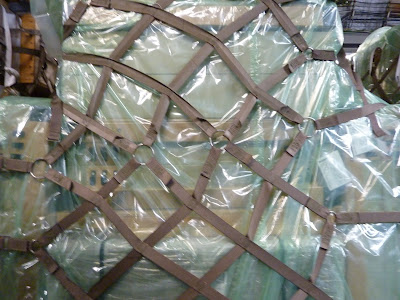
I've just started reading Ernest Shackleton's
South, a memoir of his failed 1914 Antarctic expedition. In light of this I am reluctant to whinge about the length of my trip down here, how poor the airplane food was, the jetlag, etc. Besides, it wasn't that bad anyway.
A few flights and a bunch of timezones and I find myself transplanted to Christchurch, New Zealand. We had two days here to adjust to this side of the world, provision ourselves with last minute goodies, get outfitted with all the clothing we'll need for the extreme weather down below, and fill our bellies with sushi and lamb.
In addition to long underwear, fleeces, gloves, hats, etc., everyone is outfitted with Extreme Cold Weather gear (or ECW in this land of acronyms, more on that in another post). The ECW consists of carhartt overalls, ski goggles, the iconic red parkas (known as 'big reds') and cold weather military boots (known as 'bunny boots').
On departure day we get up early, and get transferred to a special sector of the Christchurch airport where we check in and have our bags and our persons weighed. After this there is a opportunity to get a bite to eat; it is our last chance to exercise our free will of food choice for several months. Mine was an egg sandwich and a fancy fruit juice.
Next its a flight briefing. We learned how to fit earplugs, where we should sit, that we need to have our overalls undone before we enter the lavatory (for the sake of timeliness), and what what will occur in case of a boomerang. In case you don't know, a flight boomerangs when it gets close to its destination, but then has to return due to destination weather conditions. Apparently this can happen quite often. It makes a long day of sitting in a loud airplane, but also gives passengers another precious night in Christchurch. Apparently the record number of boomerangs is seven! Can you imagine logging over 70 hours of uncomfortable flight time just to get to a frozen continent???

Our chariot is an Air Force C-17. I don't know much about planes, but this one is big and gray and meant to fit both passengers and cargo.

A view from the front of the plane facing the tail. They place some airline seats across the center of the plane but many people sit along the side, facing the cargo.

My seat.

The view from my seat.

Corrine, John, Brandon, and myself.

Their aren't really any windows in the cabin of the airplane. This is quite strange because you don't get any sense of where you are, how fast you're going, or if you are taking off or landing. We were fortunate enough to have the captain invite us into the cockpit. These were my first views of the Antarctic continent.


A C-17 landing at the Ice Runway at McMurdo Station Antarctica. We made it!

And so began my Antarctic experience. For me it was only a journey of four days to reach this continent. It is truly humbling to think of the epic struggles explorers like Shackleton, Scott and Amundsen made just a century ago to reach these places. You can read more about them
here.





























